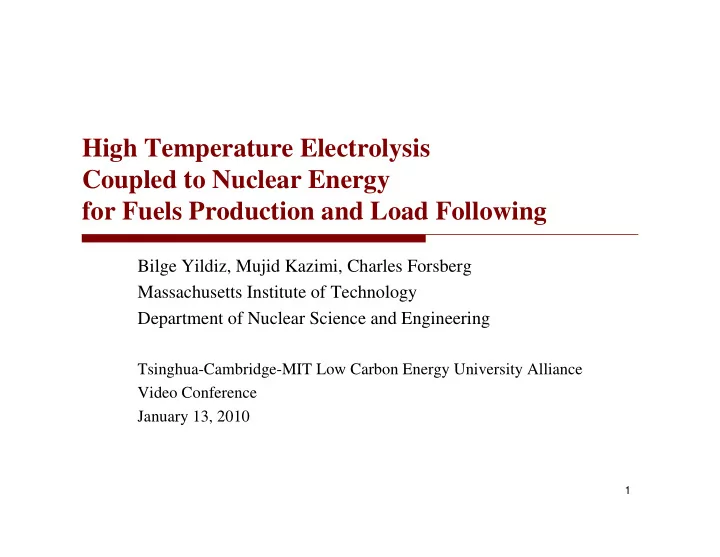

High Temperature Electrolysis Coupled to Nuclear Energy for Fuels Production and Load Following Bilge Yildiz, Mujid Kazimi, Charles Forsberg Massachusetts Institute of Technology Department of Nuclear Science and Engineering Tsinghua-Cambridge-MIT Low Carbon Energy University Alliance Video Conference January 13, 2010 1
Electricity and hydrogen / syn-gas co-generation •CO 2 -free Nuclear Electrolysis and Energy •Efficient and cost- Fuel cell processes: competitive H 2 O (g) �� ½ O 2(g) + H 2(g) •Size/location to address the industry needs Co-electrolysis: Heat and electricity H 2 O (g) + CO 2(g) �� O 2(g) + H 2(g) + CO (g) Hydrogen, syn-gas and electricity co- � generation using non-CO 2 resources; promising route to decrease CO 2 -emissions, and enable large-scale energy storage. Large incentive for a reversible high- � temperature electrolysis-fuel cell (HTE-FC). GWs of gas turbines operate at few hundred � hours per year to meet peak electricity Stoots et al., demand (very expensive gas turbine). J. Fuel Cell Sci. � HTE-FC may be much more economic than Tech. 2009 HTE because of load following capability. 2
Research approach in Laboratory for Electrochemical Interfaces ( lead by Prof. Bilge Yildiz, http://web.mit.edu/yildizgroup ) Isolate key parameters and unit processes using model systems in reaching to surface structure and chemistry in harsh environments. Surface chemical and electronic structure, laterally averaged; X-ray and Electron spectroscopies Surface electronic structure Electronic structure, cation- spatially resolved: oxygen bonding, reaction Scanning Tunneling and transport kinetics O 2 , H 2 , H 2 S… Microscopy/Spectroscopy First principles-based and O - (STM/STS) atomistic simulations e - Cathode Electrolyte GOAL: Understand the electronic and chemical behavior on oxide surfaces for energy applications: fuel cells, corrosion. 3
STM / STS set-up and experiment conditions XPS STM /nc ‐ AFM Gas doser; Omicron VT ‐ 25 oxyge, hydrogen T = 500 o C Surface cleaning P O2 = 10 -5 mbar conditions t = 20-30 min Measurement T = 23 – 580 o C conditions P surface ~ 10 -3 mbar. (example for SOFC (Tested up to 20 mbar, 500 o C.) application) 4
Example: Effect of strain in oxygen conductivity in Y 2 O 3 stabilized ZrO 2 (Electrolyte for SOFC/SOEC) Oxygen plane Oxygen plane 10 6 10 6 Oxygen ‐ Cation (O ‐ C) Oxygen ‐ Cation (O ‐ C) Cation (Zr,Y) Cation (Zr,Y) 1000 K 1000 K 10 5 10 5 bonding plane bonding plane 10 4 10 4 800 K 800 K 0 0 D O / D O D O / D O 600 K 600 K 10 3 10 3 Vacancy Vacancy critical critical 10 2 10 2 strain strain Decrease at higher Decrease at higher Increase up to a critical Increase up to a critical 400 K 400 K strains; strains; strain ( fastest strain ); strain ( fastest strain ); 10 1 10 1 Local relaxations, Local relaxations, Migration space, Migration space, 10 0 10 0 O ‐ C bond weakening. O ‐ C bond weakening. O ‐ C bond strengths. O ‐ C bond strengths. 0 0 0.02 0.02 0.04 0.04 0.06 0.06 0.08 0.08 Tensile strain Tensile strain The maximum relative enhancement in oxygen diffusivity ( D o /D o 0 ): 6.8 × 10 3 times at 4% strain at 400 K. Kushima A, Yildiz B: Oxygen ion diffusivity in strained yttria stabilized zirconia: where is the fastest strain? Journal of Materials Chemistry 2010, 20(23): 4809-4819. 5
Example: In situ characterization of surface chemistry and electronic structure �� reactivity � La0.7Sr0.7MnO3 (LSM) � oxygen electrode for SOFC/SOEC Tunneling Current (nA) 0.6 C A B 0.3 0.0 RT, 10 ‐ 10 mbar -0.3 500° C, 10 ‐ 3 mbar -0.6 500 ° C, 10 ‐ 10 mbar 200x200nm 2 800x800nm 2 -2 -1 0 1 2 Tunneling at 2 V, 1 nA Bias Voltage (V) (A) Polycrystalline La 0.7 Sr 0.7 MnO 3 (LSM) thin film surface. (B) Step height-resolution (3.9 ± 0.2 Å) on the epixatial (100) LSM surface, at 580 o C, 10 -3 mbar. (C) PO 2 -dependence of the electron tunneling at 500 o C, on (B). Katsiev K, Yildiz B, Balasubramaniam K, Salvador PA: Electron tunneling characteristics on La0.7Sr0.3MnO3 thin-film surfaces at high temperature. Appl Phys Lett 2009, 95(9), 2009 6
Example: Degradation of HTE materials Anode Poor adhesion Good adhesion 1 SSZ 3 Anode + 2 Bond Layer Bond Layer 4 10 μ m 200 μ m 20.0 µm ⎯ Mn, from the IC coating LSC Small amount of Cr Cr Sr Co • Cr poisoning • Cation / phase separation O = e - Anode Sharma VI, Yildiz B: Degradation Mechanism in La0.8Sr0.2CoO3 as SSZ Contact Layer on the Solid Oxide Electrolysis Cell Anode, Journal of The Electrochemical Society , 157, B441-B448, 2010 7
Potential project objective in this program � To identify electrode compositions that are active and durable in reversible operation of solid oxide fuel cell (SOFC) / electrolysis cell (SOEC) � Synthesize thin model films, � Electrochemical performance characterization � Correlation of electrochemical performance (activity AND durability) to surface chemistry and electronic structure. 8
University of Cambridge Atomistic Simulation Group � Background • Current Energy ‐ Related Projects • Fast ion conduction Group Leader in doped nanoscale STO ‐ YSZ Dr Paul Bristowe zirconia interface � Expertise: applied materials modeling using both classical MD and DFT � Member: UK consortium on first principles • Carbon capture in calculations (UKCP) metal ‐ organic Znbpetpa � User/developer: CASTEP DFT code framework unit cell � Energy ‐ related industrial collaborations: compounds Pilkington Glass , Philips Electronics , Osram Semiconductor s, Fiat , Bekaert Coatings • Doping mechanisms in oxide materials for � Former MIT researcher & visiting professor solar cells, sensors and displays Department of Materials Science and Metallurgy 9
Recommend
More recommend